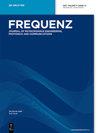Miniaturized wideband implantable slotted loop antenna for biotelemetry applications
IF 1
4区 工程技术
Q4 ENGINEERING, ELECTRICAL & ELECTRONIC
引用次数: 0
Abstract
Abstract Small size of the implantable antenna is the major concern in Implantable Medical Devices. A compact implantable wideband radiator working at the ISM band is proposed for biotelemetry applications. The overall dimension of the proposed radiator is 10 mm ⁎ 15 mm ⁎ 0.8 mm and the thickness includes substrate and superstrate thickness. The Coaxial feeding method is employed here. The inner and outer diameter of the coaxial feed is 1 and 1.5 mm respectively. The design process starts with a creation of rectangular patch of size 10 mm ⁎ 15 mm and the coaxial feed is located at (2.5, 7). Then slot like loops are introduced on a rectangular patch. This compact size is achieved by introducing small loops on a rectangular patch along with triangular cuts at the bottom right and top-left of the patch. The antenna is simulated with a tissue model (Skin, Fat, Muscle, Bone) and measured with a Body Equivalent Fluid (phantom). The −10 dB bandwidth is obtained over 1340 MHz (1.66–3 GHz) and the fractional bandwidth of 54.7% at the ISM band. The simulated gain and radiation efficiency of the radiator are −13.5 dBi and 3.15% respectively. The measured return loss of the proposed antenna is −30.53 dB and the SAR value averaged over 1 g tissue is 302.6 W/kg with 1 W input power. When compared to the previous works mentioned in the literature the proposed antenna displays wider bandwidth, high gain, low SAR and high radiation efficiency.用于生物遥测应用的小型化宽带可植入开槽环天线
摘要在植入式医疗器械中,小尺寸的植入式天线是主要关注的问题。提出了一种工作在ISM波段的紧凑型植入式宽带辐射器,用于生物遥测应用。所提出的散热器的整体尺寸为10 mm 15 mm 0.8 mm,厚度包括衬底和衬底厚度。本文采用同轴进给方法。同轴进给的内径为1 mm,外径为1.5 mm。设计过程首先创建尺寸为10 mm 15 mm的矩形贴片,同轴进给位于(2.5,7)处。然后在矩形贴片上引入槽状环路。这种紧凑的尺寸是通过在矩形贴片上引入小环以及在贴片右下角和左上角的三角形切口来实现的。天线用组织模型(皮肤、脂肪、肌肉、骨骼)模拟,用等效体液(体模)测量。在1340mhz (1.66 - 3ghz)频段获得−10db带宽,ISM频段的分数带宽为54.7%。仿真所得的辐射增益和辐射效率分别为- 13.5 dBi和3.15%。在输入功率为1w时,天线的回波损耗为−30.53 dB,在1g组织上的平均SAR值为302.6 W/kg。与已有文献相比,该天线具有带宽宽、增益高、SAR低、辐射效率高等特点。
本文章由计算机程序翻译,如有差异,请以英文原文为准。
求助全文
约1分钟内获得全文
求助全文
来源期刊

Frequenz
工程技术-工程:电子与电气
CiteScore
2.40
自引率
18.20%
发文量
81
审稿时长
3 months
期刊介绍:
Frequenz is one of the leading scientific and technological journals covering all aspects of RF-, Microwave-, and THz-Engineering. It is a peer-reviewed, bi-monthly published journal.
Frequenz was first published in 1947 with a circulation of 7000 copies, focusing on telecommunications. Today, the major objective of Frequenz is to highlight current research activities and development efforts in RF-, Microwave-, and THz-Engineering throughout a wide frequency spectrum ranging from radio via microwave up to THz frequencies.
RF-, Microwave-, and THz-Engineering is a very active area of Research & Development as well as of Applications in a wide variety of fields. It has been the key to enabling technologies responsible for phenomenal growth of satellite broadcasting, wireless communications, satellite and terrestrial mobile communications and navigation, high-speed THz communication systems. It will open up new technologies in communications, radar, remote sensing and imaging, in identification and localization as well as in sensors, e.g. for wireless industrial process and environmental monitoring as well as for biomedical sensing.
 求助内容:
求助内容: 应助结果提醒方式:
应助结果提醒方式:


